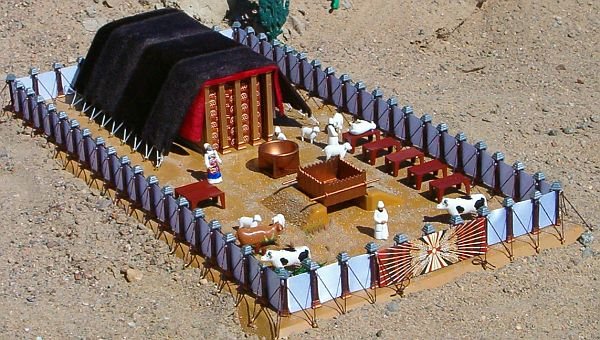Why Study the Tabernacle (or Temple)?
- Elohim commanded his people to study it. In Ezekiel 43:10–11, YHVH tells Ezekiel to explain to his people the layout of the temple “that they may be ashamed of their iniquities [Torahlessness]” and presumably repent or return to a spiritual relationship with him.
- Elohim commanded his people to build the tabernacle (and latter the temples, see Exod 25:8; 29:43; 1 Chron 17:11–15); therefore, it must be important, and we should study it to understand its significance. After all, one-half of the Torah and one-third of the 613 Torah commandments deal with the temple, so it behooves us to understand it’s spiritual significance.
- Elohim’s name resided in the tabernacle (and temple, Deut 12:5–6), and it’s where his place of abiding on the earth (Exod 25:8).
- Both the tabernacle and first and second temples in Jerusalem were the spiritual centers for the nation of Israel. Elohim’s manifest presence was found within these physical structures, and this phenomenon powerfully unified the 12 tribes of Israel making them feel as though they were one nation under YHVH’s divine protection and guidance (Exod 40:34–38). The temple became the focal point for all worship for the entire nation (Ps 5:7). For example, it was the place where YHVH chose to place his name and where all Israelites were to gather three times each year at YHVH’s appointed times (Deut 12:5, 11, 21; 14:23, 24; 16:2, 6,11; 26:2).
- The tabernacle (temple) was a monument to Elohim’s sovereignty. It was the place where he dwelt and where men come to commune with the Sovereign King and Creator (Exod 25:8; Pss 26:8; 27:4; 65:4; 92:13–15).
- It was a place to renew Israel’s covenant with Elohim. When the Israelites came to the temple to give their offerings, to make sacrifices and to commune with YHVH during his appointed times, they were doing so out of obedience to his covenants he had made with them. In so doing, they were renewing that covenantal relationship with him.
- The tabernacle and temples were the place where atonement for sin was made through the sacrifices that were offered there.
The Benefits of Studying About the Tabernacle?
- It teaches us how to properly approach a holy Elohim through turning from or repenting of sin (Ezek 14:6).
- It reveals YHVH’s plan of redemption.
- It teaches us about the priesthood of Messiah (Heb 7:26–28).
- It helps us to understand the kingdom of Elohim, which is an essential element of the gospel message (Mark 1:15–15). Yeshua will rule the earth during the Millennium from his temple in Jerusalem (Zech 14:4, 8–9, 11; Rev 20:6; Matt 6:9–10; Ezek 44:23 cp. 2 Cor 6:17).
- The tabernacle teaches us how to order our lives. Even as the morning and evening sacrifices were conducted in an orderly manner following certain protocols, this teaches us how to order our daily lives around our devotions to Elohim. The biblical feasts (the weekly and annual sabbaths) also revolved around the tabernacle, even as our lives should revolve around these feasts that help lead us into the presence of and relationship with Elohim as represented by the tabernacle.
- It helps us to recognize and avoid idolatry and all manner of abominable and worldly practices because it teaches us the importance of holiness when approaching a holy Elohim.
- It teaches us to be conscious about dwelling (living our lives as if we were) in the very presence or courtyard or throne room of Elohim.
- Everything in the tabernacle (and temple) pointed to Yeshua’s atoning death on the cross for our sins, and his work as our Great Heavenly High Priest Advocate who is presently at the right hand of the Father in heaven. It reveals to us the gospel message in an active and pictorial way. All these things are for our learning and admonition (1 Cor 10:11; Rom 15:4).
References
- These points were taken from the Hebrew Roots magazine, Jan–March 2011, and was written by Dean Wheelock.
- To learn more about the Tabernacle of Moses, go to http://hoshanarabbah.org/pdfs/tabernacle.pdf.



Brother everything in the Old Covenant Scriptures was a picture of things to come. A picture of the coming Messiah, the workings of the Set-Apart or Sacred Spirit, the believer saved by faith. We have something wonderful the those of the Old Covenant did not have. We are the Temple, and the Set-Apart Spirit of Elohim lives in us. And He has written His Torah of Love, the Ten Commandments of Love on our hearts. Amen!
Amein and amein. One of the slogans of our ministry is to “Connect the message of the gospel with its pro-Torah Hebraic roots.”
I agree, one of the worst thing a new believer can be told is to focus on studying the New Covenant Scriptures, because the Old Covenant is out of date. This is so untrue, because to really understand the New Covenant you have to understand the Old Covenant. And the Torah, or Ten Commandments are very much still in effect, because the Master said, “If you love Me, keep My Commandments.” What were His commandments? To love YHWH your Elohim with all your heart, with all your strength, and with all your being, and to love your neighbors as yourself. He did not change the commandments, He just summed them up into two commandments. Amen!
Hallelujah amen!
Stay tuned. More is on the way!
In other words: wrought through His living and written Word: Yahusha/ Torah: a new creation which only ( can ) lives through the Spirit. 🙂
How much are you charging for the model of this Tabernacle of Moses?
This is not my model of the tabernacle to sell. This image came off the internet, and so far as I know, it is not copyrighted, but is free to use for non-commercial purposes under the Creative Commons usage. If I am mistaken on this, someone please inform me otherwise.